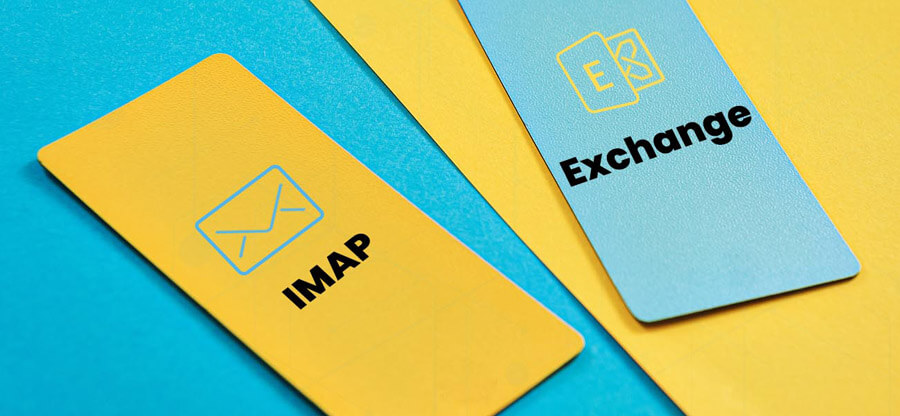Read time 4 minutes
Many users are confused between IMAP or Exchange when they configure their Outlook email client application. They can answer this question in this article, which is prepared for pointing out differences between both configurations.
IMAP
IMAP or Internet Message Access Protocol is a standard internet protocol utilized by email clients to access messages through mail servers working on TCP/IP connections. The default IMAP server listens to port number 143 while IMAP over SSL/TLS listens to port number 993. Currently, there are many IMAP-supported email servers, email clients, and web-based email services. Usually, they provide support to both POP3 and IMAP protocols for configurations. It is built with the objective of storing emails on the server always until someone deletes them from there.
Exchange Server developed by Microsoft is a mail server that uses MAPI protocol to connect to email clients and the standard Simple Mail Transfer Protocol or SMTP to link with other email servers. It is available as on-premises and Software as a Service as per the requirement. Exchange emails can be accessed via some email clients like Outlook, Windows Live Mail, etc. It offers ActiveSync for cross-platform synchronization, online services with Microsoft 365 Exchange Online, hosted Exchange services, some third-party services, and more.
In order to avoid confusion, there is a need to compare both services and find out the best suited for the organization at present.
|
Comparison Factor |
IMAP |
Exchange |
| Basics | Message Access Protocol | Mail Server |
| Protocol | Internet Message Access Protocol | Use MAPI (proprietary) protocol to connect to email clients |
| Storage | Store inbox emails on the server and sent items locally on the desktop, and can download emails for offline access | Stores both inbox and sent emails on the server, which can be accessed through supported webmail or email clients |
| Modification | Emails deleted or moved on the server gets automatically modified from the respective client and vice versa | Modified content on configured email clients would update it on the server as well. |
| Synchronization | Server-based email synchronizing with visibility in multiple email clients | Server-based email, calendar, contacts synchronizing (Exchange Active Sync) |
| Services | Email management only | Emails, Contacts, Calendars management |
| Devices support | Apps on laptops, mobiles, tablets, systems, etc. | Mail apps on Android, iPhone mobiles, tablets, iPads, etc. |
| Offline Accessibility | No such facility requires email client online for access to emails | Provides users offline access to mailboxes in the cached mode where they can read, view, or edit emails which get updated as soon as there is network connection and configuration of Outlook email client with Exchange Server |
| Favorable when | Mail server is connected to multiple devices simultaneously | The organization already using Exchange Server |
| Supported email clients | Gmail, Outlook, Thunderbird, Notes, Zoho Mail, Yahoo Mail, Notes, Outlook.com, Office 365, etc. | Microsoft Outlook for Mac, Microsoft Outlook for Windows, Outlook Web Access, Outlook app for iOS and Android |
After you have checked the differences between IMAP and Exchange and taken an evaluation of their features, then you can decide that which server is best for you.
- If you want to access your entire mailbox (inbox, outbox, sent items, contacts, etc.) from multiple devices, then you should use the IMAP server.
- If you want to access your mailbox with better protection, synchronization, and collaborative features, then you can use Exchange Server.
Do you Need to Migrate IMAP to Exchange?
If your organization uses IMAP but wants to use an Exchange Server mail server, we got you the best migration tool to backup or migrate IMAP mailboxes to Exchange Online and on-premises. The tool supports almost all IMAP servers for migration and offers single/multiple mailbox migration to public folder, archive mailbox. It integrates smart filters for moving the desired data. To get a complete idea about the tool, it is better to visit the website and work on its trial version available on the same link-https://www.nucleustechnologies.com/imap-to-office-365/
A- No. Exchange Server is a mail server and utilizes proprietary protocol MAPI to establish a connection with email clients like Outlook for sending and receiving emails.
A- No. Only emails are synchronized with the IMAP server and can be accessed on multiple email clients
A- The main credentials required to add an on-premises Exchange Serve account as the destination in the Kernel IMAP to Office 365 tool are – Exchange Server name, mailbox login ID, and password information.
